Hi everyone, and happy new year! We’re kicking off 2024 with a cultural post. Today, I’m talking a little bit about my Chinese post-childbirth confinement experience after having my first baby!
Feel free to skip this post if you’re just interested in recipes. This winter, we’re making this Northern Chinese Sour Cabbage Pork Belly Stew and my aunt’s Ham & Bean Soup!
About Chinese Confinement
We detailed what the confinement period is in this post, but if you missed it, Chinese confinement is known as zuò yuè zi (坐月子) in Chinese, which translates to “sitting the month.” It’s basically a time of rest for the birthing parent, emphasizing the parent’s recovery in addition to the care of the newborn.
In the West, it feels like the focus of the postpartum period is all on the baby. Which of course it should be! But in many cultures around the world, there is also an emphasis on caring for the person who just gave birth to that little baby!
While the word “confinement” tends to have a negative connotation, I think this cultural practice is such a positive one. When you have a newborn, some pediatricians tell you to maintain a “cocoon” with very few people in and out to protect the baby’s health. That might be a more intuitive way to describe Chinese confinement for new parents too.
As a newly minted mom (sometimes I just feel like a person who now has a baby—it still feels weird to think of myself as a mom!), it helped me remember to take care of myself as well as baby Ethan. Because if we don’t take care of ourselves, it makes it that much more difficult to care for others, not to mention a newborn.
While pregnant, I had plenty of time to think about how I wanted to approach it, and the research we did to write the confinement period posts gave me plenty to think about—namely, why it’s important, how it’s been adapted by modern Chinese moms, what my mom thought was important, and how I could make it work for my preferences.
Like our recipes, Chinese confinement practices have been passed down from generation to generation. I was to eat certain foods, dress warmly and make sure I wasn’t exposed to anything cold (a big confinement no-no), get lots of rest, and generally stay indoors/avoid visitors when possible.
Here’s how it went!
At the hospital
I ended up having an emergency C-section, so I spent a couple extra days recovering in the hospital. It can be difficult to follow Chinese confinement practices in a hospital environment—particularly the “rest” part and the “stay away from outside visitors” part.
I think that during my entire four and a half day stay at the hospital, I got a grand total of 6 hours of sleep. It was BY FAR the most sleep-deprived I’ve ever been in my life.
Between the labor and delivery, getting the hang of taking care of a newborn, and all the drop-ins by doctors, nurses, and maintenance staff—checking vitals, administering medicine, checking on the baby, emptying the garbage cans in our room, stopping in to get forms filled out, etc.—it was hard to get a 15-minute nap, let alone any significant stretch of sleep.
That said, I did my best to do what I could to stick to the plan—I tried to keep nice and warm, and my parents delivered some black chicken soup with nourishing dried mushrooms, cooked vegetables, rice, and steamed salmon with lots of ginger for us to eat. After the C-section and a couple days without regular meals, that food felt life-giving!
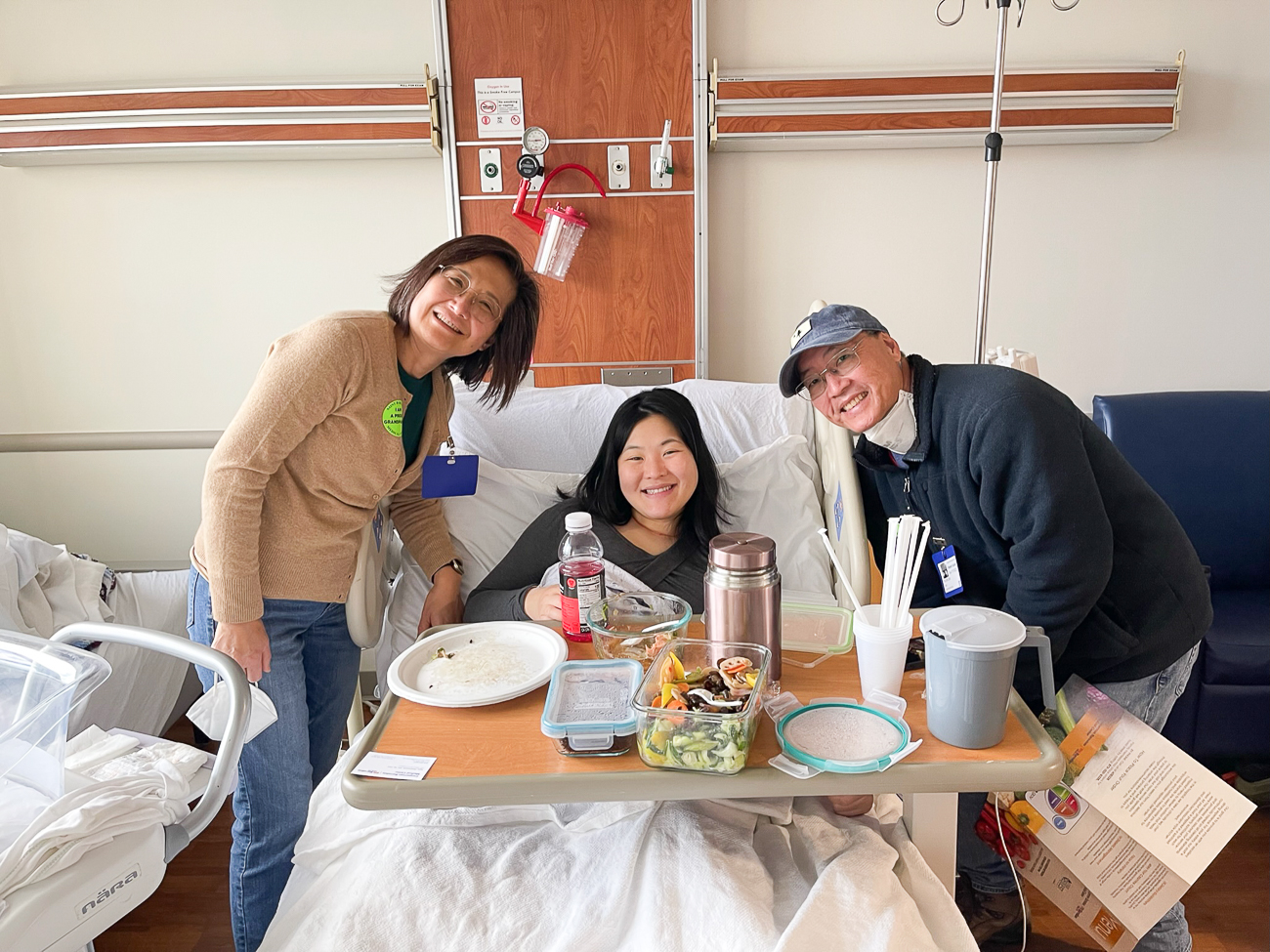

My mom tells a similar story. After giving birth to me (also via C-section), she ate a whole fish in the hospital! (This, after 9 months of not being able to stand the sight or smell of seafood. My pregnancy was mercifully free of any food aversions.)
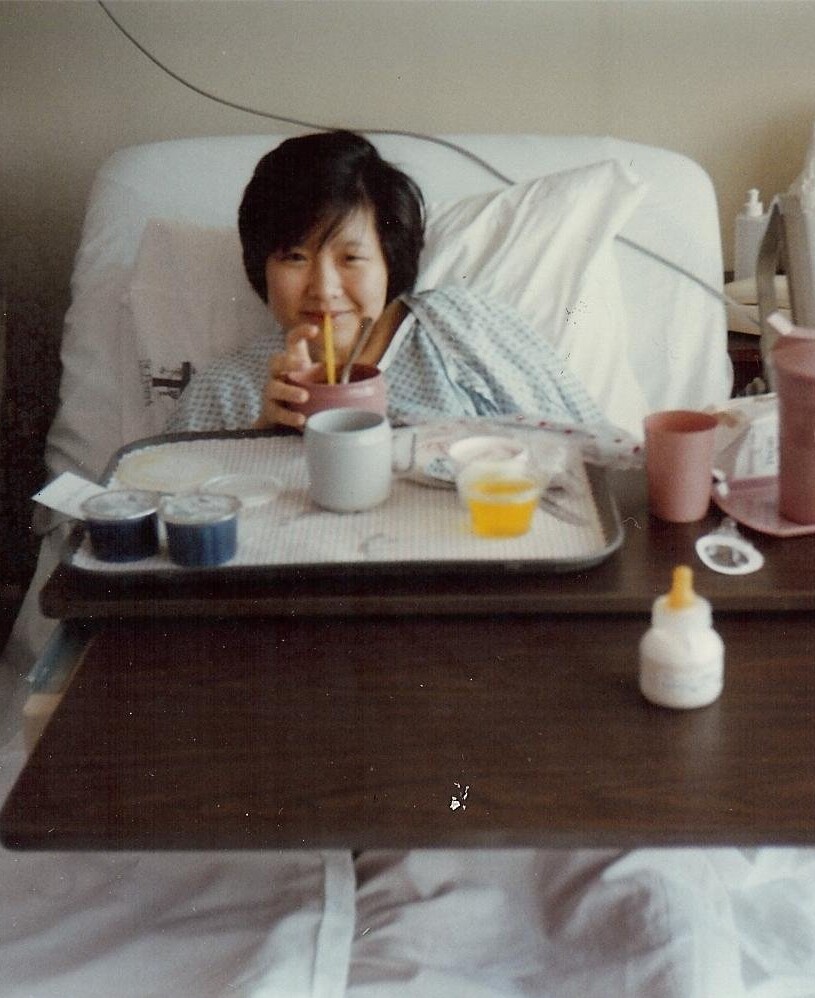

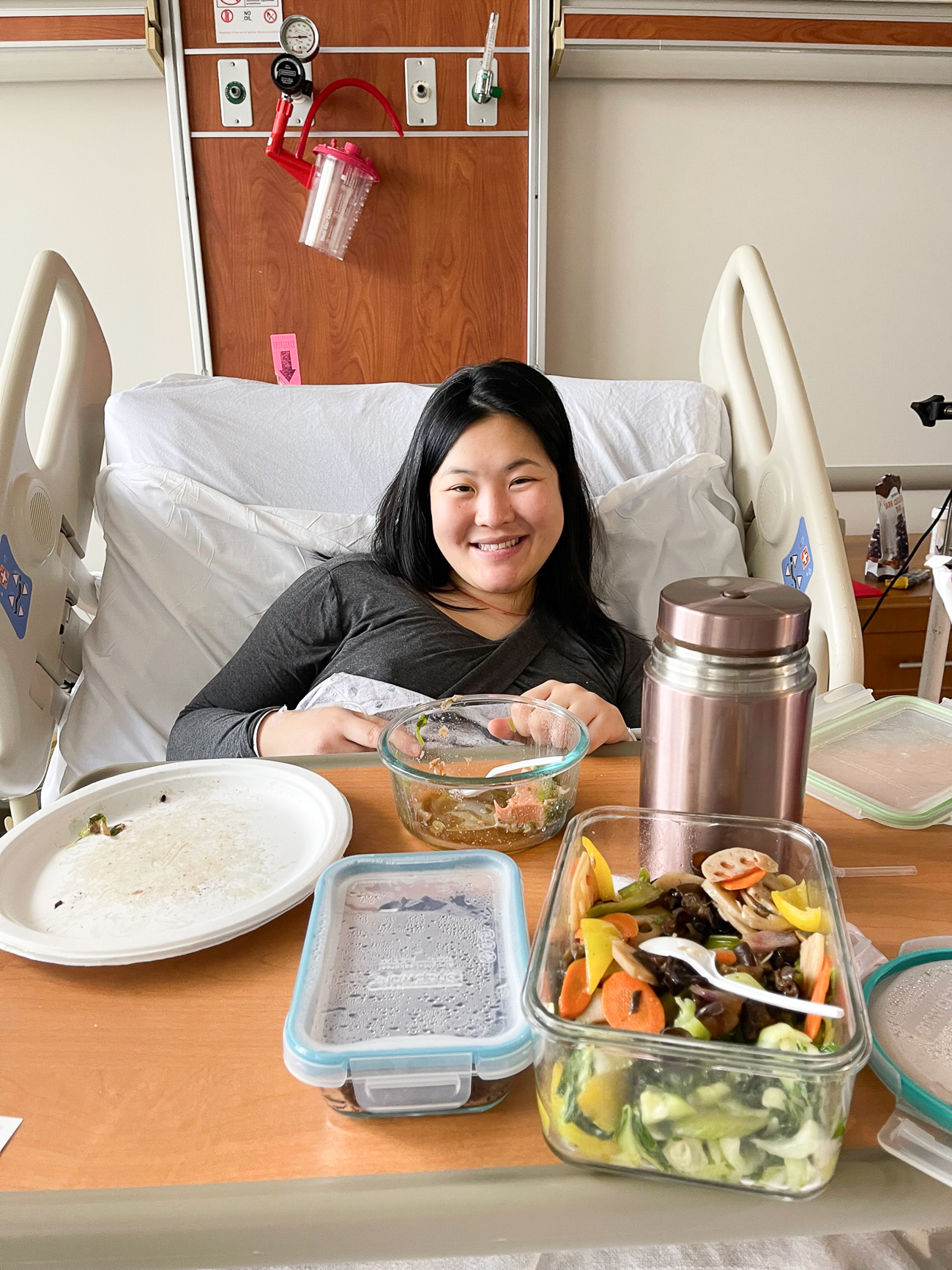

Our hospital room had a mini fridge, so we were also able to keep and reheat leftovers!
Despite the sleep deprivation, what was nice about the hospital was having the postpartum nurses around to help as we were getting the hang of the whole new baby thing!
Among the things we learned: how to swaddle like a champ (Justin), how to feed the baby (me), the art of diapering, how to get wiggly and curled arms and legs into a footed onesie, and various burping strategies.
Each nurse had a different tip or trick to share, and we learned a ton. It was the silver lining of a longer than average hospital stay.
Going Home
When we were finally able to head home, my mom delivered another life-giving meal. A fish tofu soup made with a whole barramundi and lots of ginger, scrambled eggs and yellow chives, blanched choy sum, and steamed black rice.
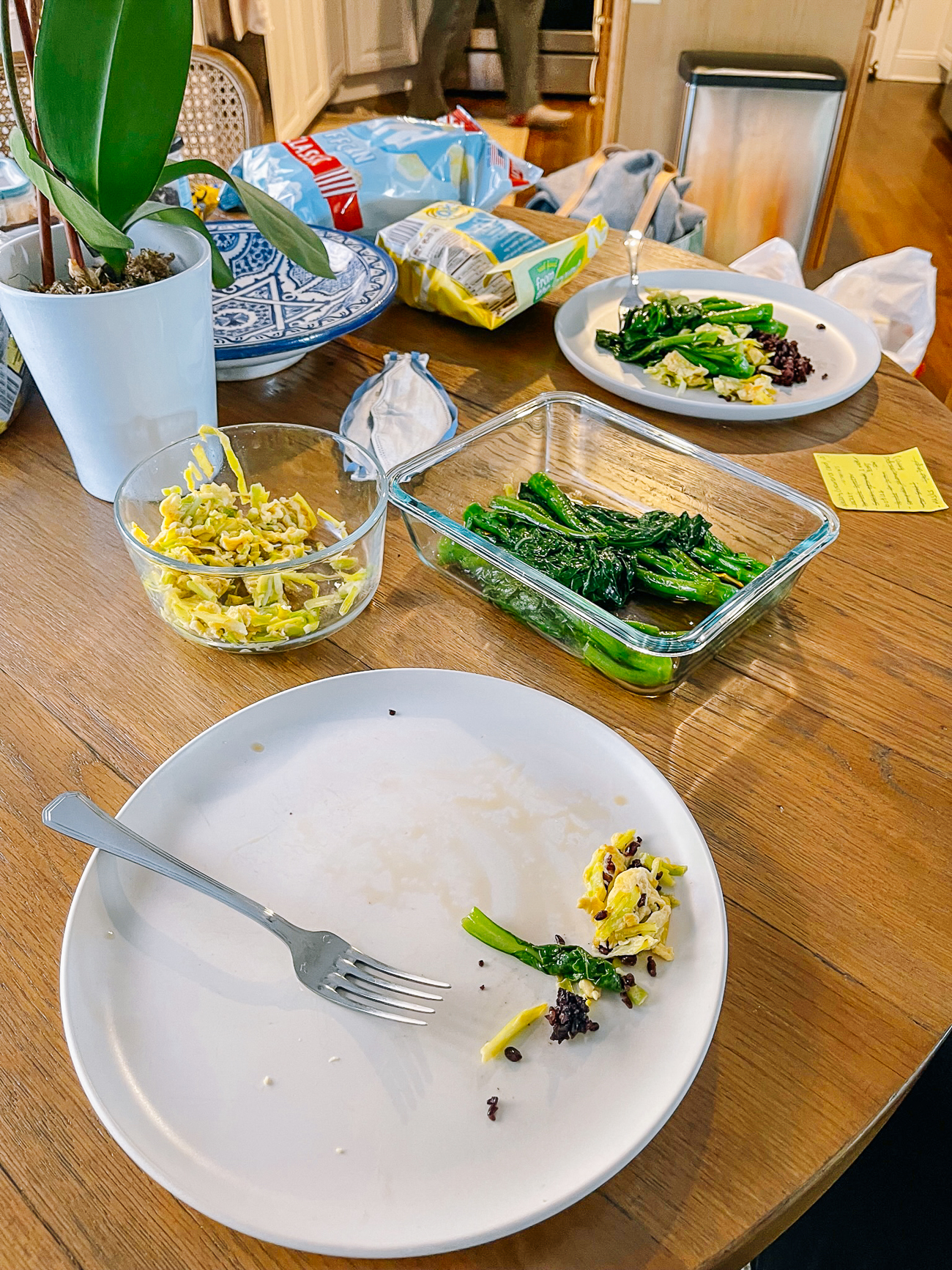

I am normally not at all a fish soup kind of person, but the enthusiasm with which I attacked that fish was kind of crazy.
I’m also not normally someone who enjoys eating bits of ginger (I love the flavor it gives to dishes, but treat it as an aromatic that I generally pick out). Yet I was also eating the slices of ginger without complaint.
Eggs had never tasted so good, and I was also downing the veggies and rice with gusto. No joke, it was one of my most enjoyable meals of 2023.
This showed me that perhaps all the Chinese moms are on to something with these recommended confinement foods. I couldn’t believe how much my body was craving hot soups, easily digestible protein, nourishing vegetables, and warming ginger.
I think we got 5 or 6 hours of sleep that night, but it was still the most consecutive sleep we’d gotten in several days. It was time for some serious rest!
The Art of Resting—With a Newborn Baby
Okay, so…easier said than done.
How does one rest when you’re not supposed to have visitors, and you have a crying, pooping, hungry little baby to take care of?
Well for one thing, having someone—whether it’s a partner, a grandparent, a sibling, or a friend—there to help makes a huge difference.
My parents, in true Woks of Life style, were delivering containers upon containers of soups, porridge, stir-fries, and fresh produce every couple of days, and Justin took the lead on warming our meals, cleaning, and also his baby care territory—diapers and swaddling!
Even though we were being cautious about having visitors, we did have my parents come in with masks to help on occasion. (Kaitlin had already gotten a cold and then the flu in rapid succession, so we weren’t taking chances.)
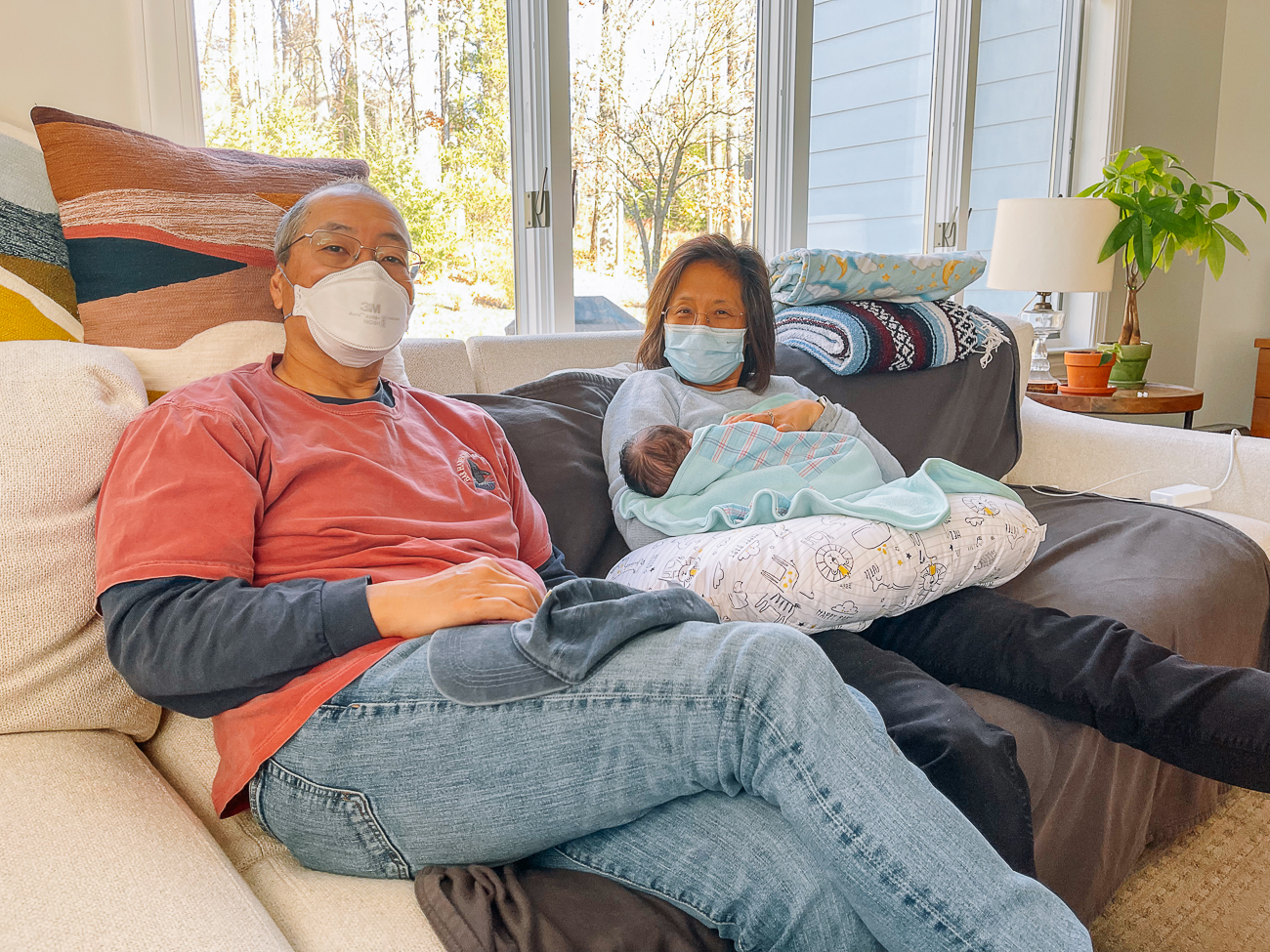

We also caught naps when we could, while the baby was sleeping in his bassinet.
In order to promote separate daytime/nighttime routines and ease any day/night confusion in the little guy, we set up a daytime area in the family room downstairs and a nighttime area in our room.
Downstairs, we made the couch nice and cozy with blankets, comfy pillows from our guest bed (get those real nighttime sleep pillows for your daytime naps—it makes a difference), a downstairs diaper changing station to save time and make changes more convenient, and the bassinet for the baby’s daytime naps.
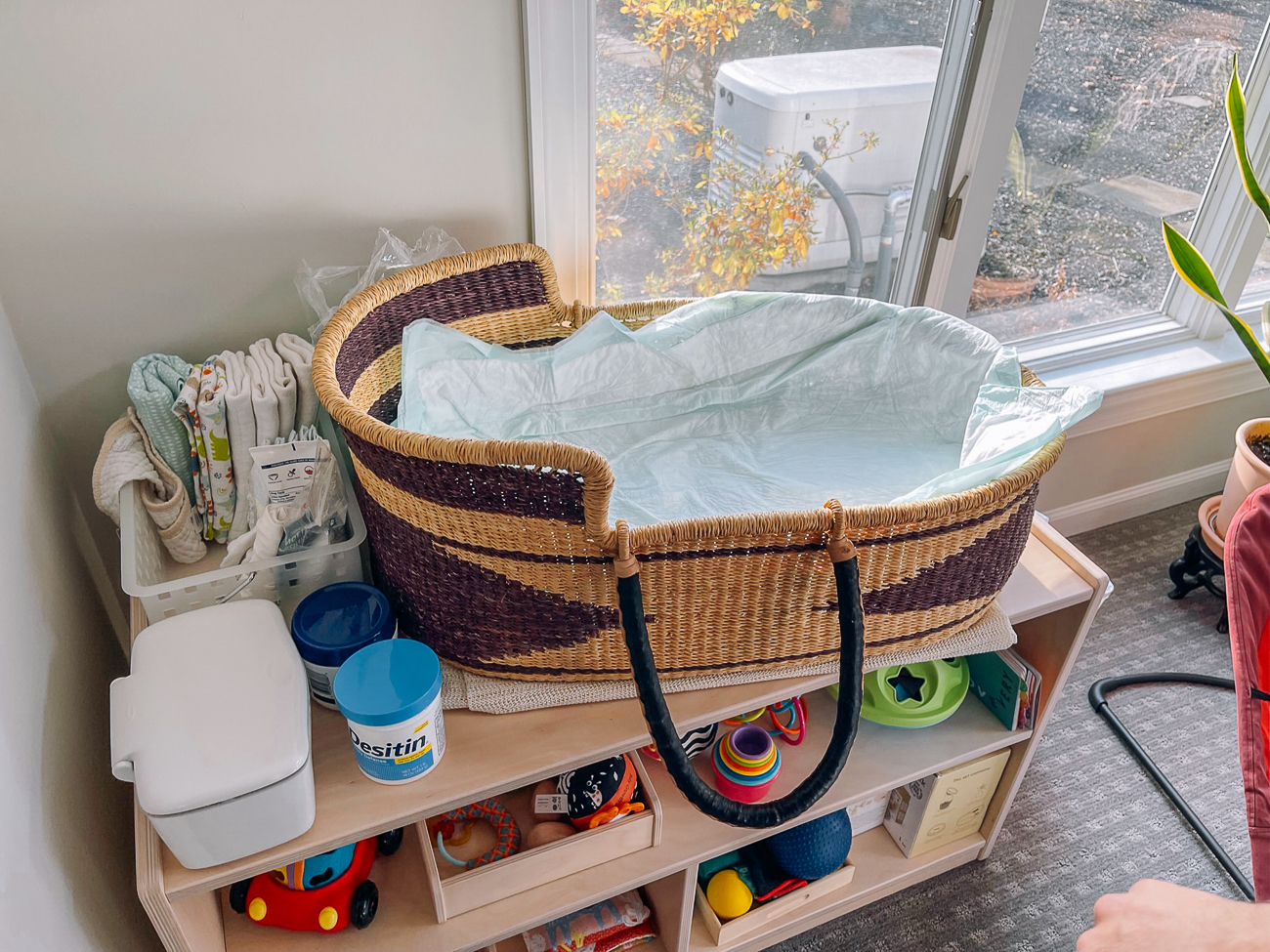

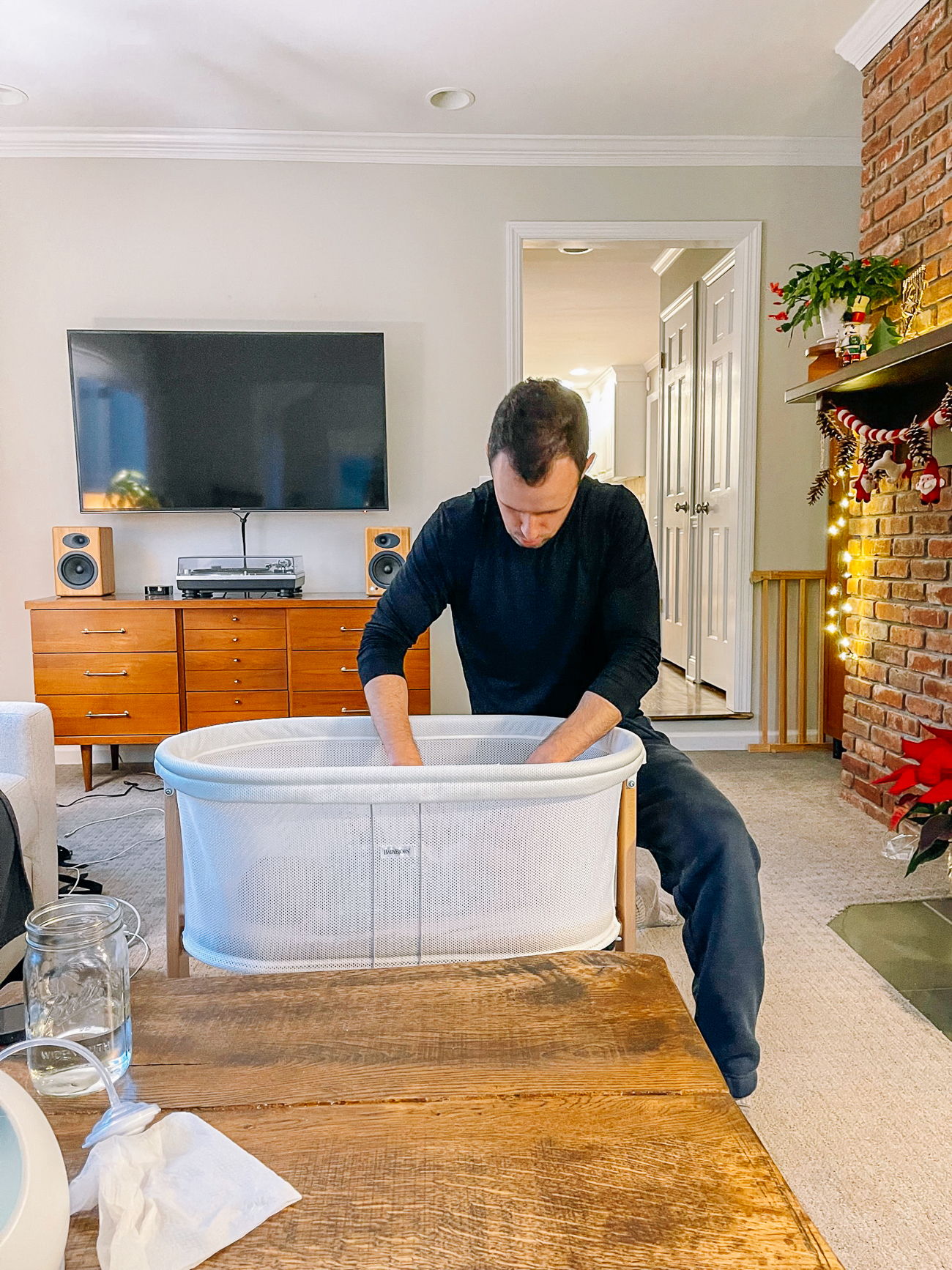

Upstairs, we had a diaper changing station right in our room, since the baby slept in the bassinet next to our bed. This made it quicker for us to get right back to sleep after middle-of-the-night wake-ups.
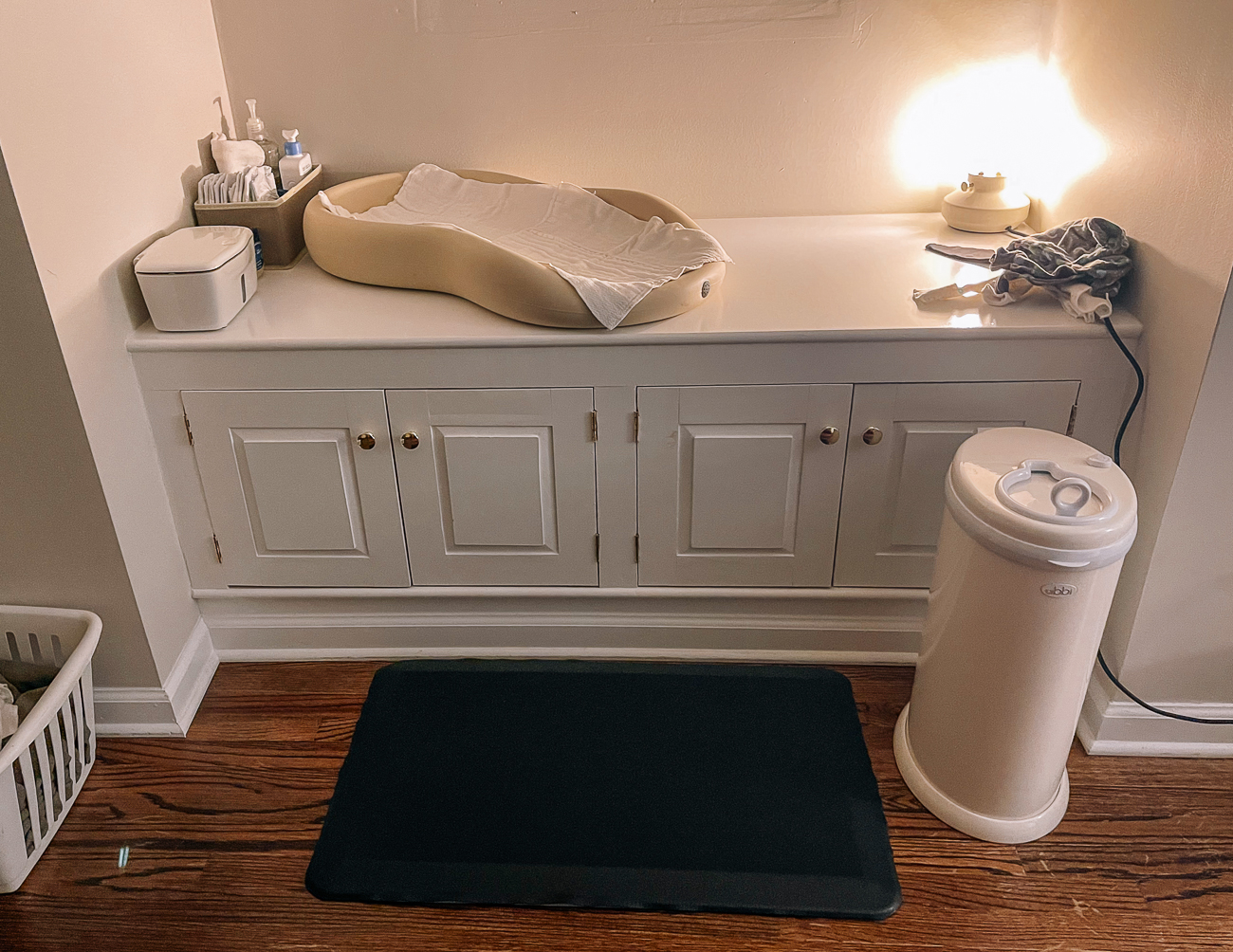

We did all of this not only for convenience, but also so that we could also just lie down and nap whenever the mood struck!
It can be hard to get rest for yourself in those first weeks, but it helps to be prepared to catch an hour of sleep whenever you can manage to put the baby down for a nap.


My Confinement Menu
Since we already wrote an entire post about the Postpartum Chinese Diet, I won’t go too far into it here. Generally, confinement foods include soups, lots of cooked vegetables, proteins like eggs, fish, and chicken, steamed dishes, and warming ingredients like ginger, black sesame, garlic, onion, and rice wine.
We had a bunch of soups ready to go in our freezer, including the recipe we recently published for Postpartum Pig Feet Papaya Soup, but my mom was also continuing to make a steady stream of soups for me. (Kaitlin, nursing her cold/flu in her apartment, also got a soup delivery.)
Here’s one example of a typical confinement meal: scrambled eggs with chives, steamed tofu with mushrooms and lily flower, a vegetable stir-fry, and a black chicken soup with goji berries and Chinese dates.
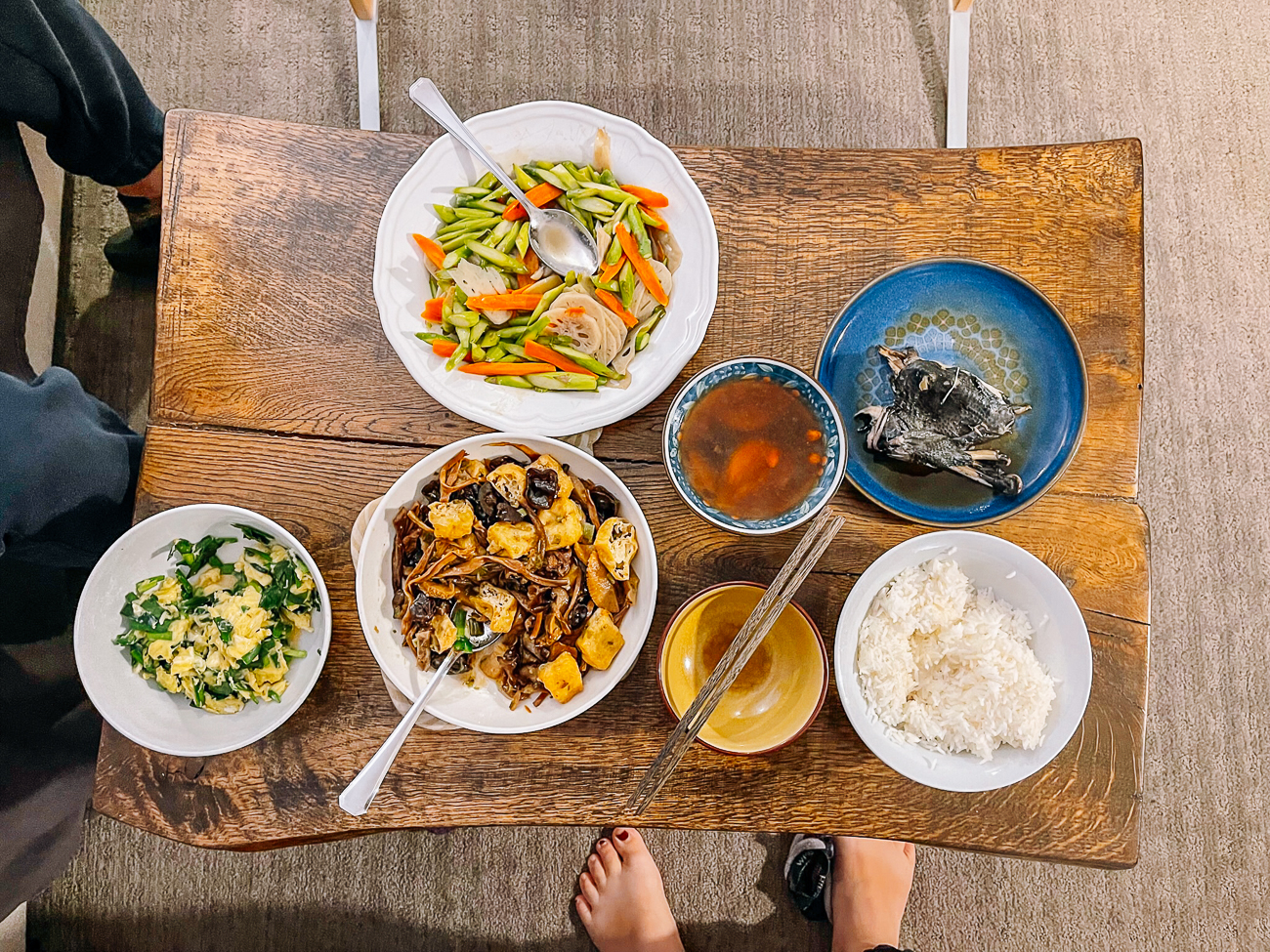

We also enjoyed my mom’s Taiwanese Sesame Oil Chicken Soup, which includes copious amounts of warming rice wine and black sesame oil, as well as LOTS of fish soup. If whole fish isn’t your thing, you can also make fish soup with filets, like in this Easy Fish Tofu Soup recipe.
We ate all this with steamed rice, onto which I would sprinkle black sesame seeds!
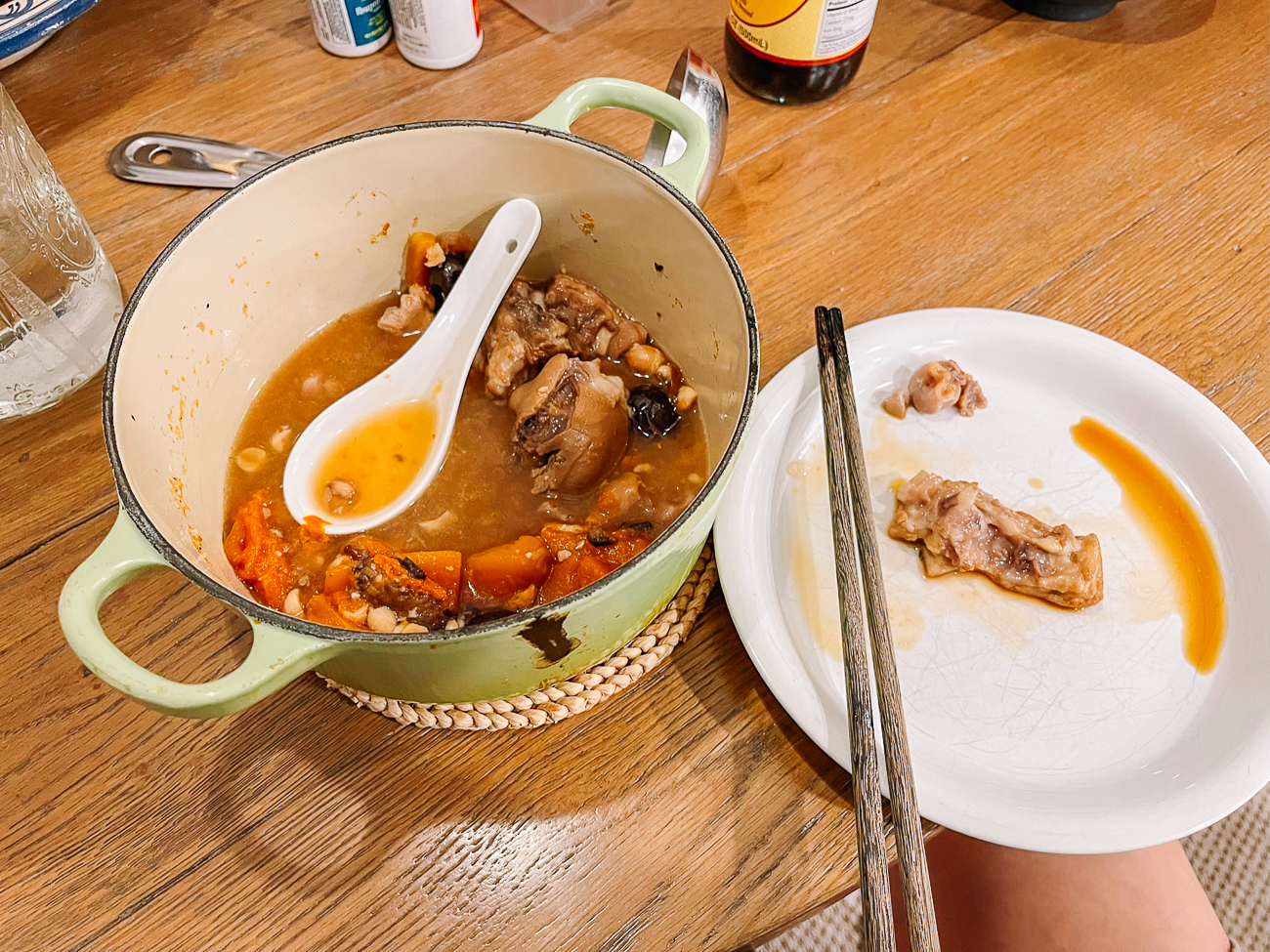

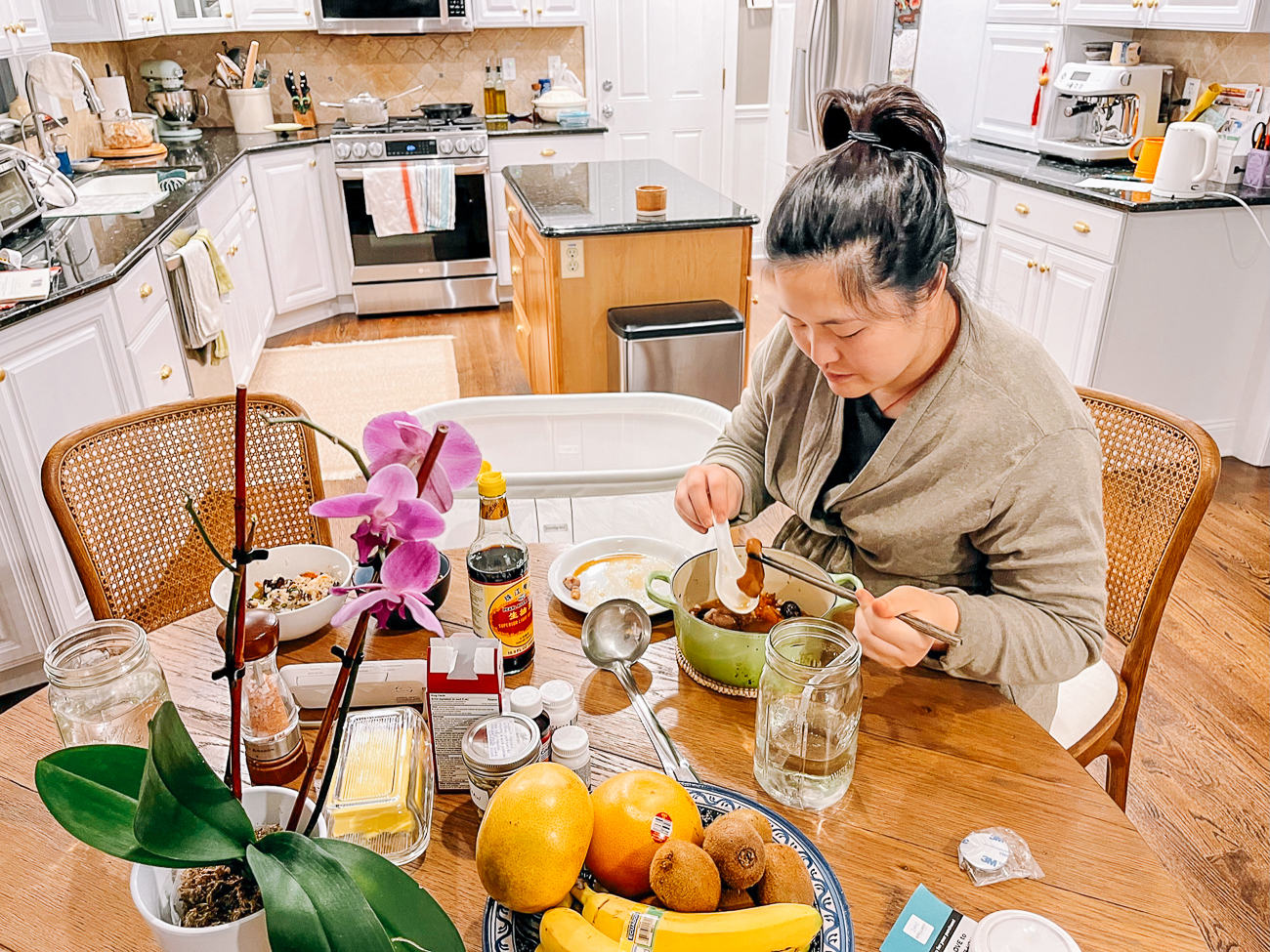

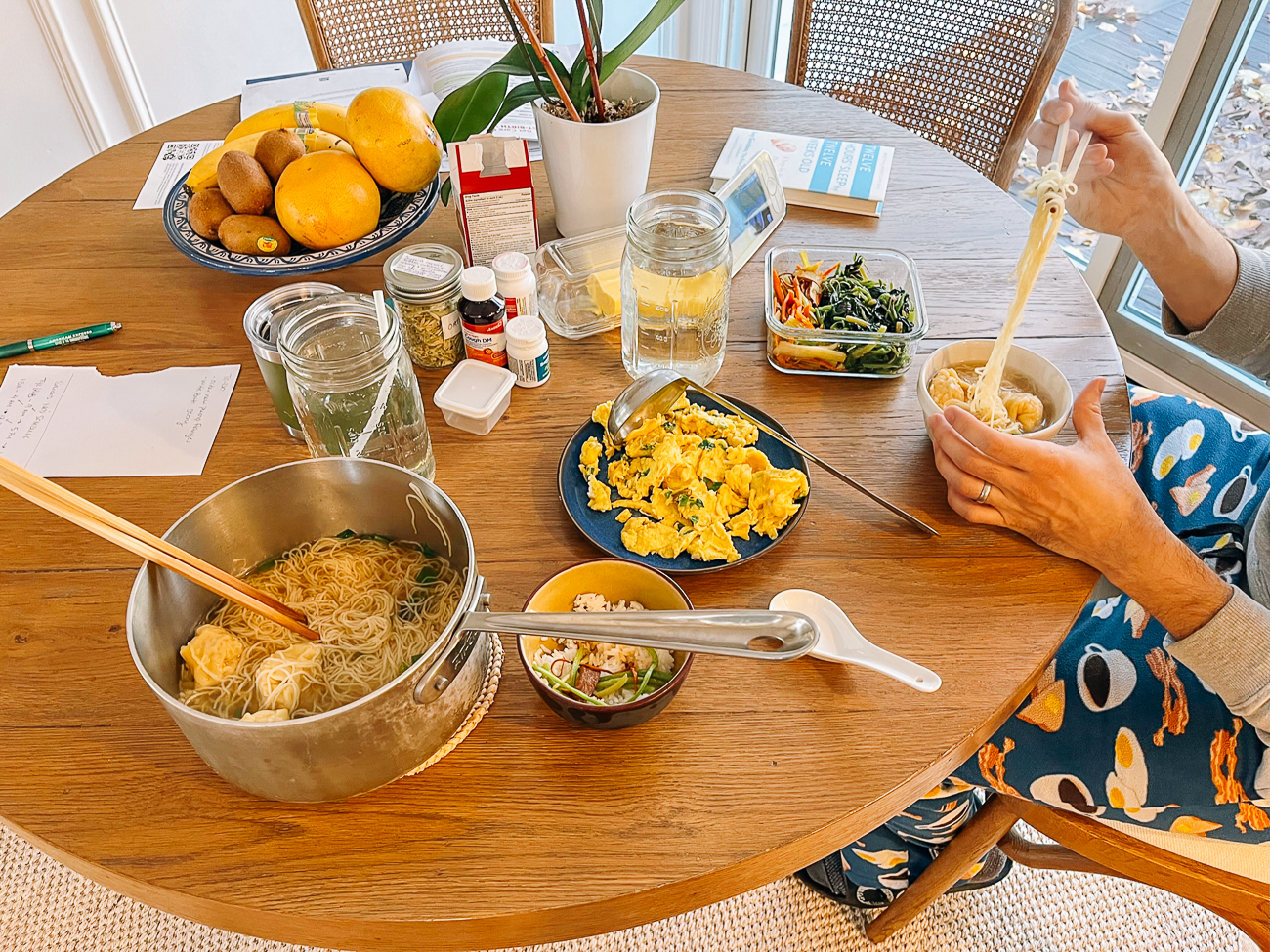

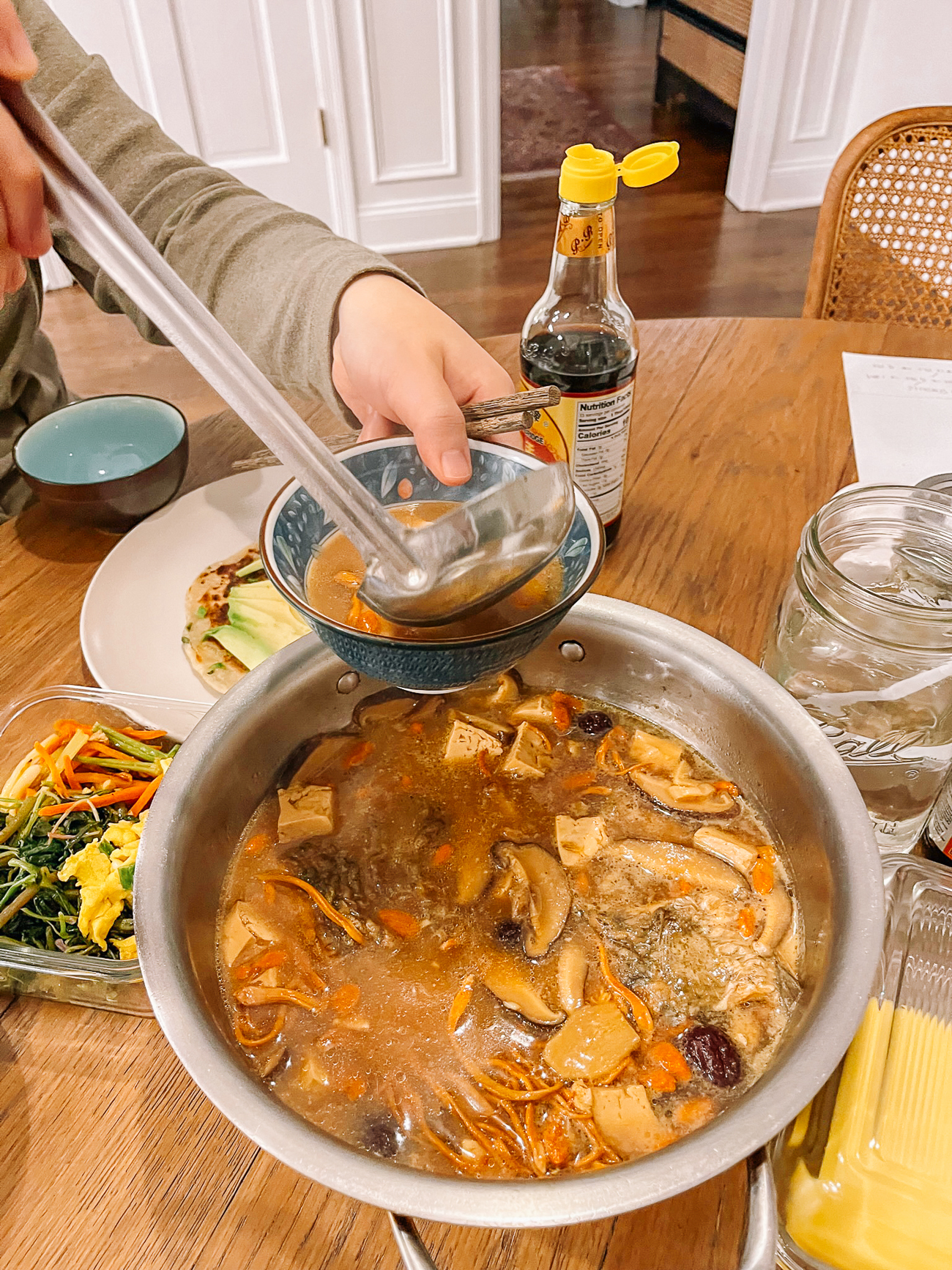

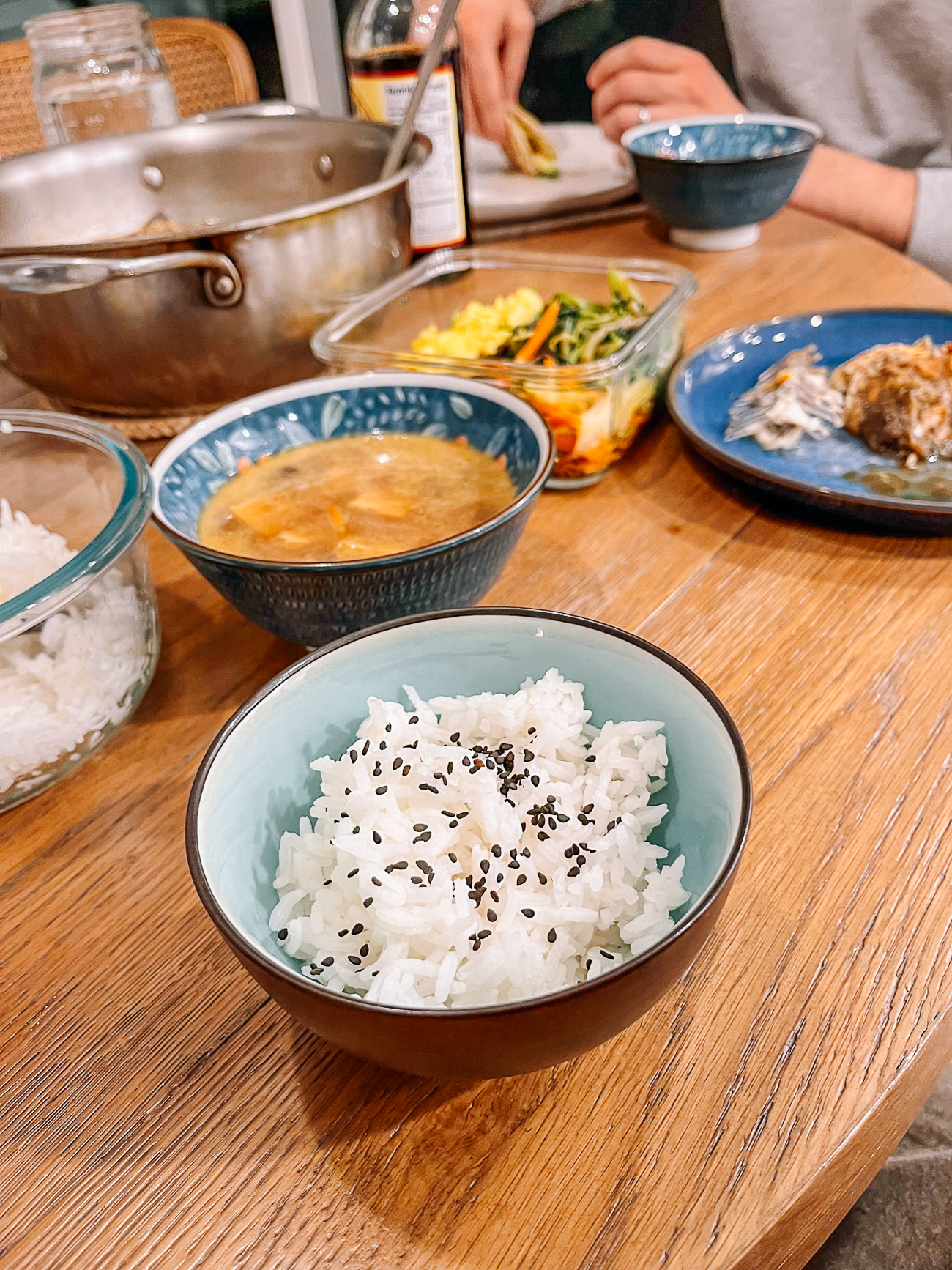

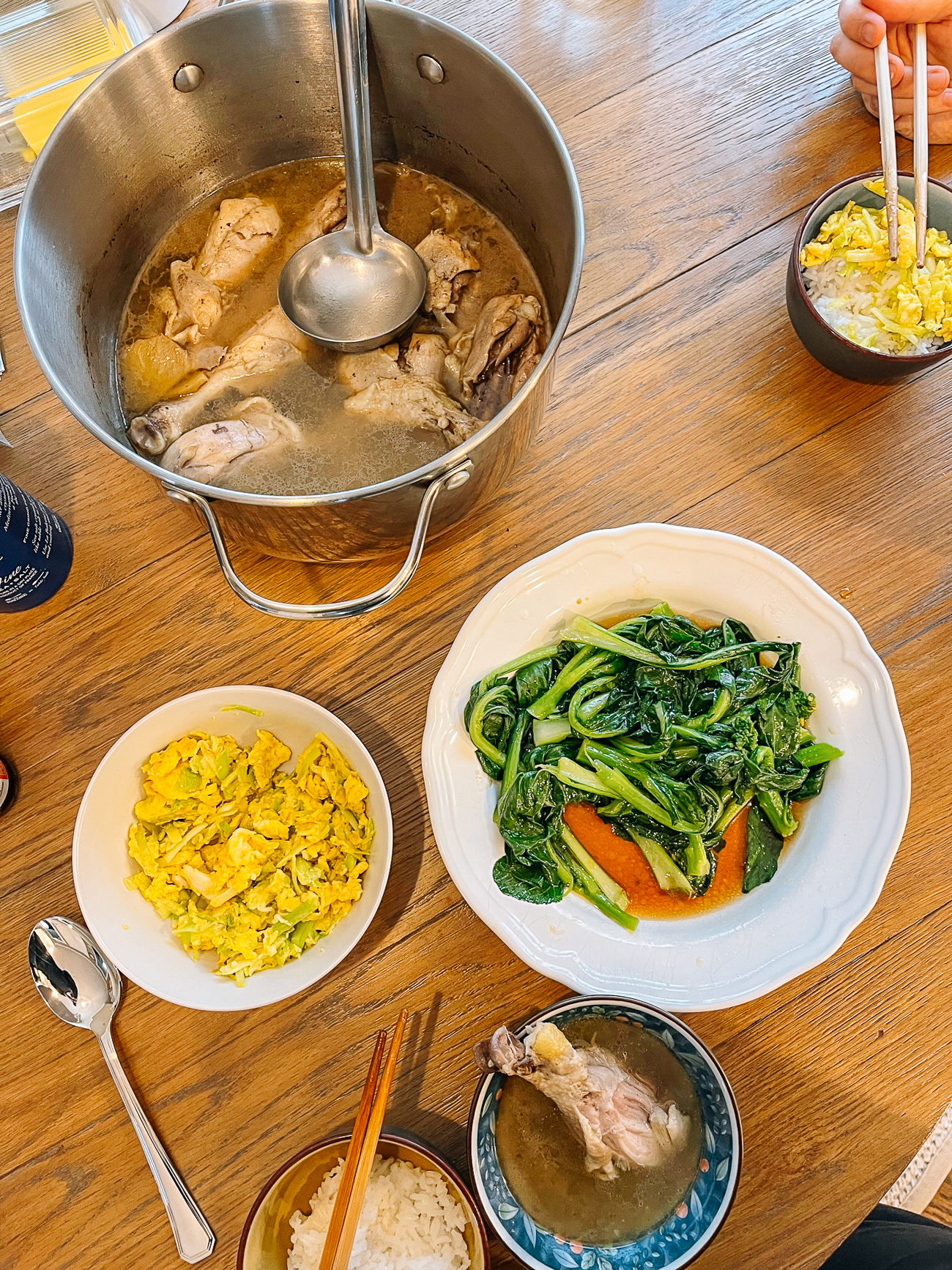

For breakfast, we enjoyed porridge with Chinese black sugar, as well as healthy proteins like eggs with mushrooms and spinach, healthy fats from avocado, and sourdough toast.
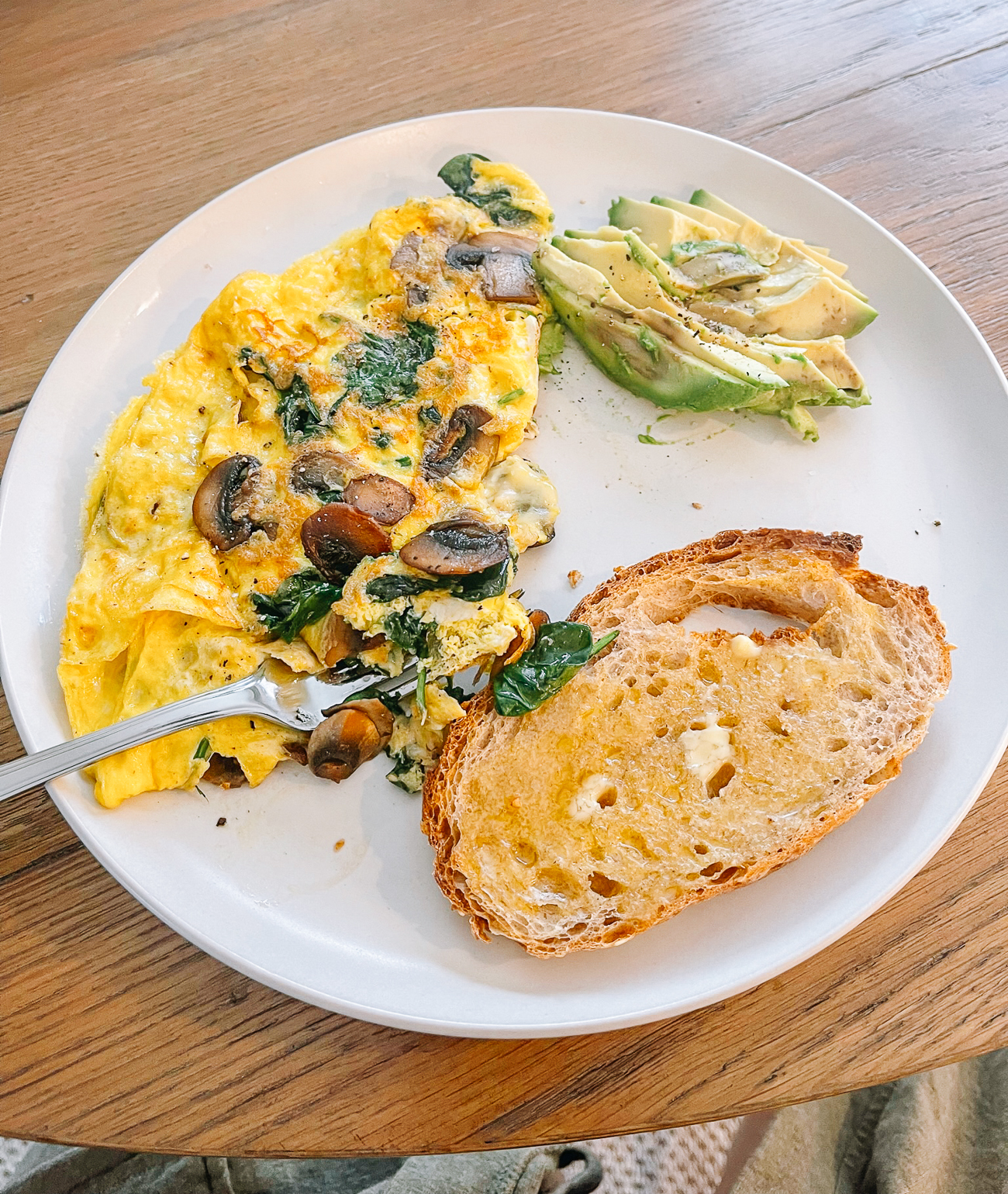

In addition to these meals, Kaitlin and my mom also trekked out to Chinatown to an herb shop to get me a special blend of herbs known in Chinese as Shenghua Tang. It’s a Chinese herbal tea that is supposed to help support the recovery of the womb.
You’re supposed to drink it during week 1 postpartum. I got a 5-day supply—lucky me!
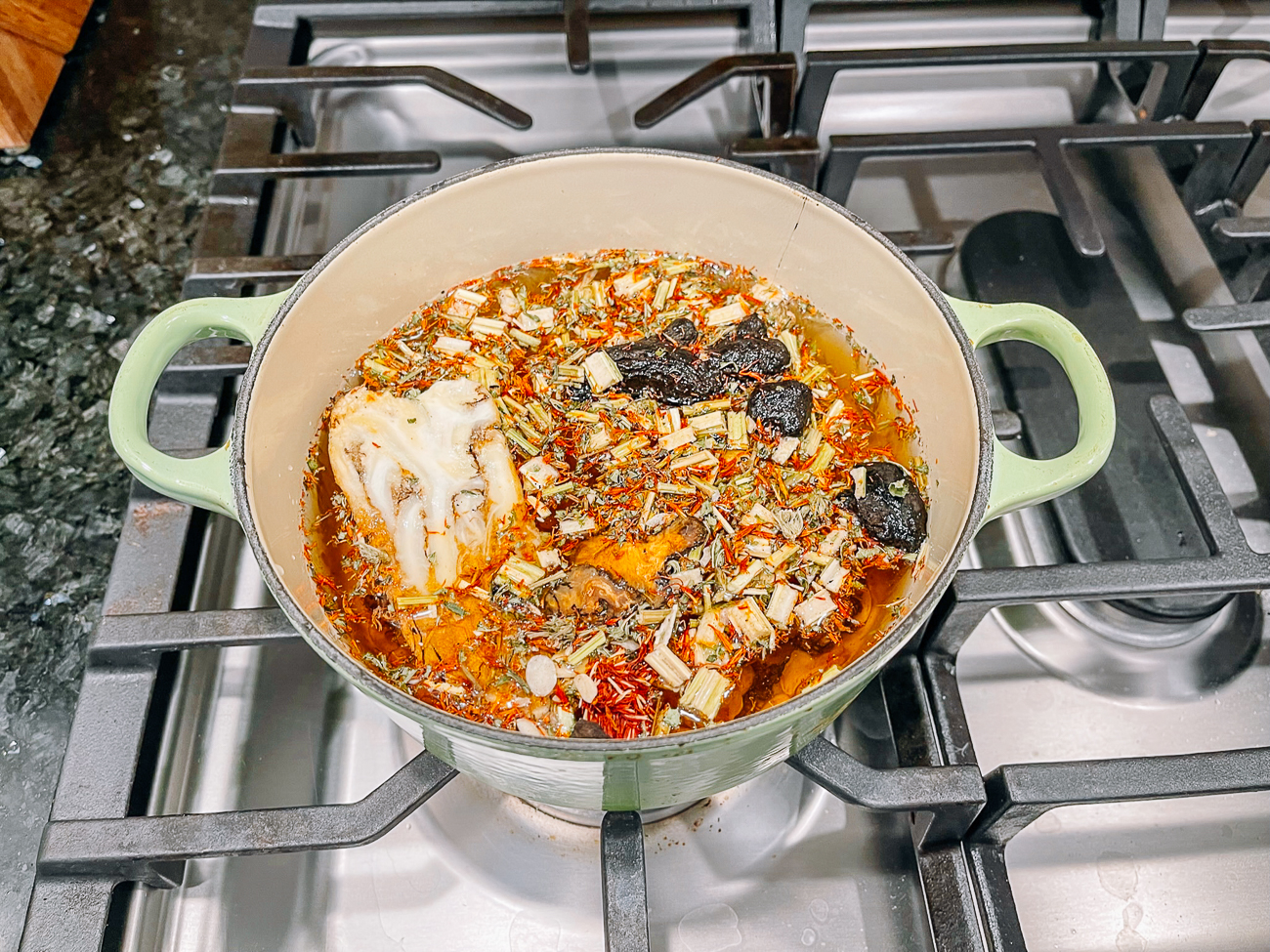

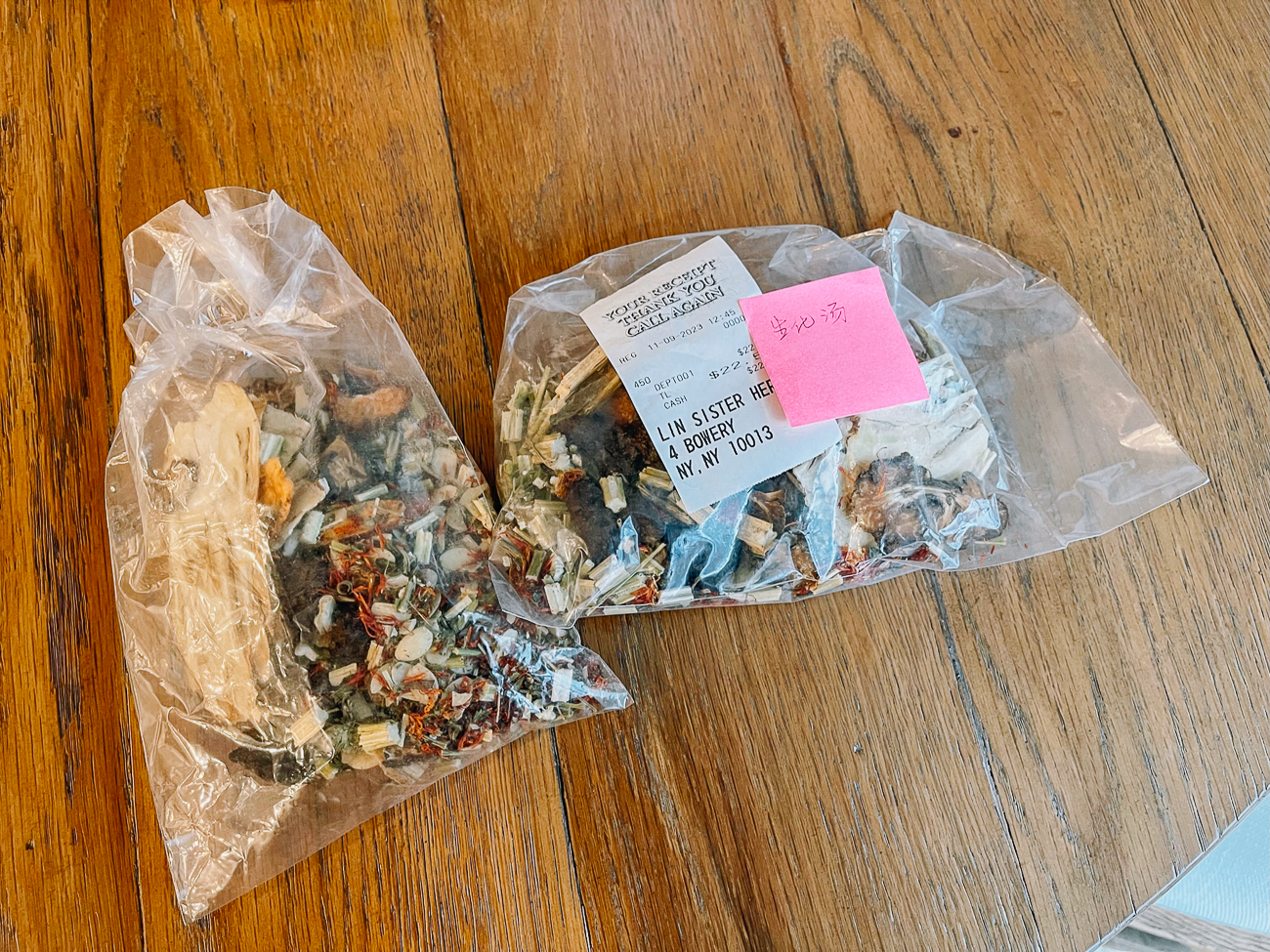

I gotta tell ya, it wasn’t the most pleasant-tasting beverage I’ve ever had. Basically, you pour all the ingredients into a pot, add several cups of water, and boil it. Once boiling, you reduce it down to an 8 ounce portion, so it’s nice and concentrated, and drink it hot.
I got through my 5 bags—and the bits of sediment at the bottom of each and every cup—like a dutiful Chinese daughter.
It wasn’t all fish soup and herbal tea, though. We deviated from the confinement menu a bit to celebrate Thanksgiving!
We had a pared back Thanksgiving menu since it was just the 5 of us (or wait…6 of us! Though Ethan didn’t partake in the turkey). Because Kaitlin was still a bit under the weather, we ended up picking up Thanksgiving dinner from my parents’ house.
We had pumpkin and apple crumb pie, delicious Grandpa’s Turkey, mashed potatoes, the best herby stuffing I think my dad has ever made, fresh rolls, veggies, gravy, and cranberry sauce (our family likes the canned jellied stuff).
(Kaitlin here: while I was down for the count with a cold when the baby was born, I did manage to rally to make the mashed potatoes, rolls, and gravy for Thanksgiving!)
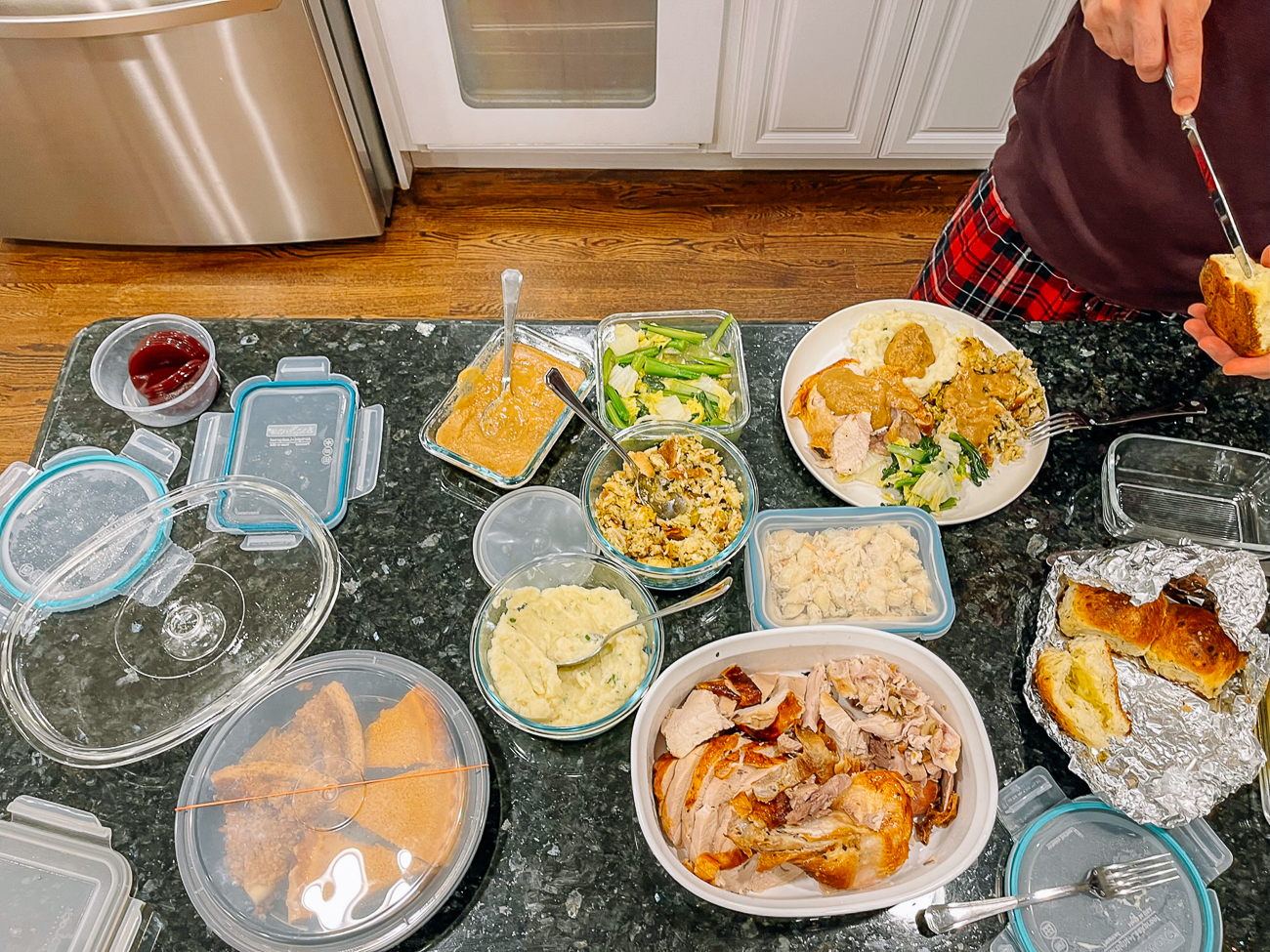

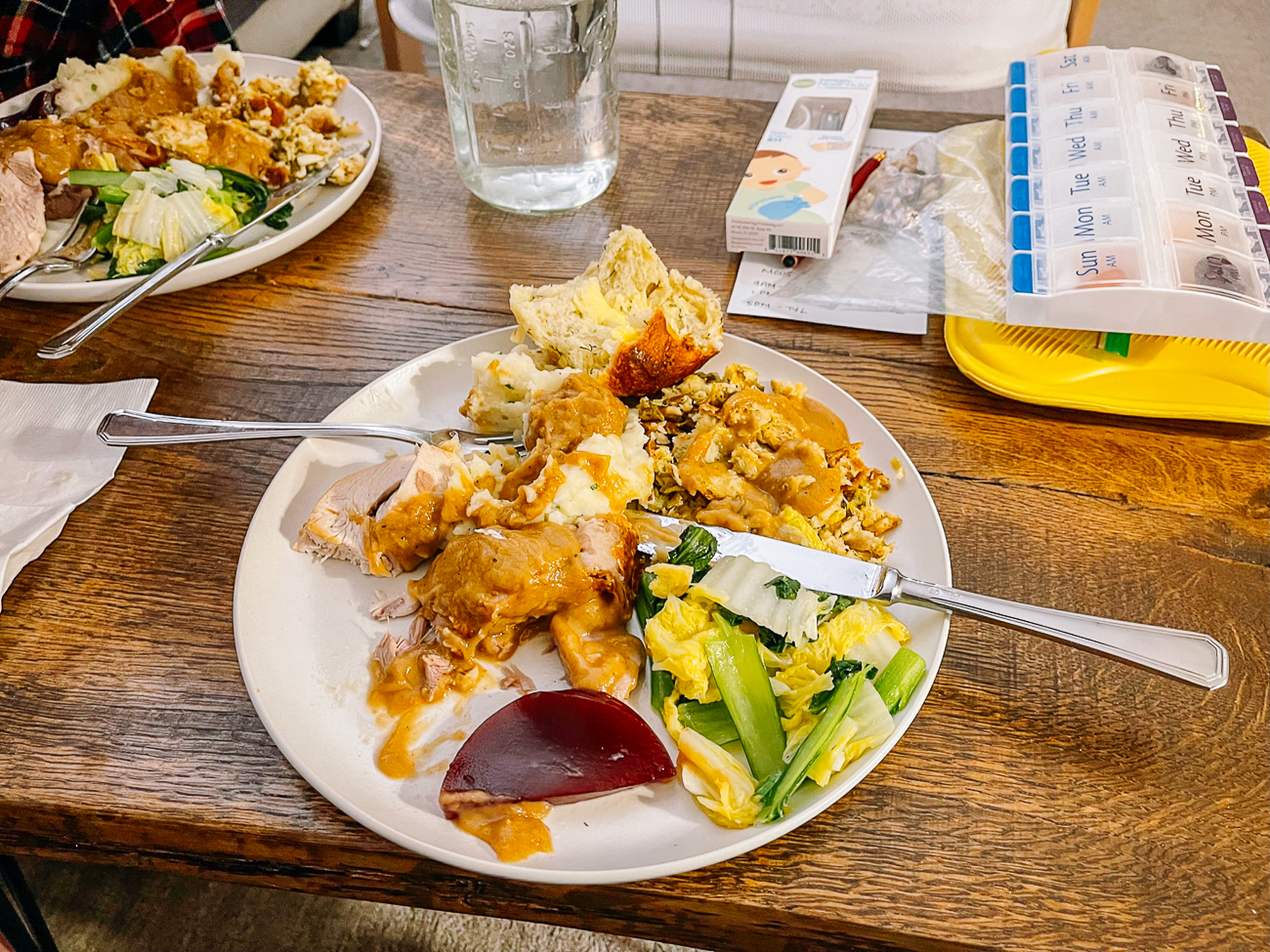

As you can see, I’m a very happy camper:
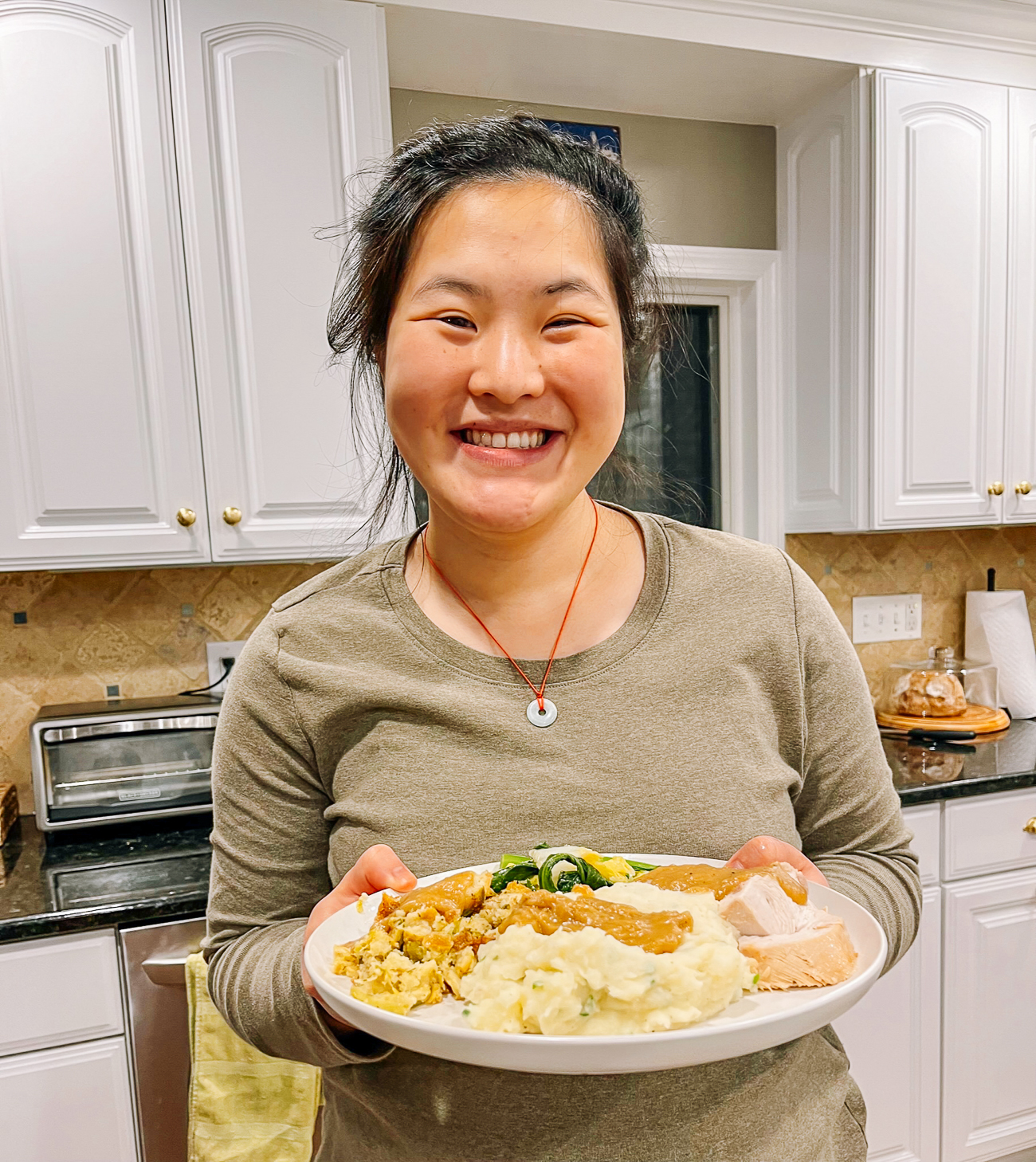

(Though I did have to chug one of those herbal teas after this.)
My Confinement Routine
If you’ve heard of Chinese confinement, you may be thinking:
- “Isn’t it true that you can’t wash your hair for a whole month??”
- “Are you allowed to shower at all?”
- “Did you wear a hat and scarf indoors?”
- “Did you seriously not leave the house for 30 days?”
Yes, when you think of Chinese confinement, you start to think of all these rules around it that the old Chinese grandmas might have told you about: no washing your hair, bathing less (or not at all), bundling up in warm clothes, and staying in the house.
The idea behind many of these rules is that the postpartum body is a depleted one that no longer has a balance between yin (cold) and yang (warm) energy. Your body is in a yin state, and to aid recovery, you must re-balance it—hence the warming foods and the avoidance of cold.
You also have to understand that many of these seemingly draconian rules were dreamt up in a time when many homes didn’t have hot running water or electricity!
Here’s how I interpreted the rules and made them work for me:
- I did not shower at the hospital after the birth. The first time I took a shower was when I got home, 4 days later. Because I was recovering from a C-section, I didn’t feel up to taking a shower anyway. It takes a lot of energy, and I was barely able to get out of bed! Instead, I kept myself warm under blankets, and while I didn’t get much sleep, I was able to rest my body.
- When I did get home, I limited hair washes to every other day, or every couple of days. I heated up the bathroom before I went in, and if I did wash my hair, I blow-dried it right after!
- I may not have worn a scarf and hat indoors, but I did dress warmly in a robe, and always warm socks!
- We turned up the heat in the house a couple degrees to ensure that the temperature was always warm.
- I avoided drafty areas of the house.
- We turned up the water heater, so that the water in the shower/sinks got hot quicker!
- I did leave home, but only for the baby’s doctor’s appointments. Other than that, I mostly stayed indoors.
- I rested as much as I could, and didn’t do any strenuous physical activity. Justin helped with most of the household chores, so I wouldn’t have to do too much.
These felt less like rules that I was following, and more like common-sense measures to make sure I was comfortable during recovery.
My mom would’ve wanted me to follow a few more rules better, like only drinking hot or warm water, and wearing a warm hat and scarf outside (I didn’t do this because they were quite a few warm 60°F days). And while we did have many soups, she would’ve preferred us to eat soup with every single meal!
She also made this truly, ah, “challenging” soup—dried kelp with soybeans and pig feet—that she would’ve preferred we finished with more enthusiasm. Justin, the consummate supportive husband, ate it with me.
I was also feeling pretty stir-crazy by the 30-day mark, so while the confinement period after a C-section generally lasts 2 weeks longer (45 days), I decided I was done after 30.
If you’re expecting, just know that you can dictate your own confinement experience to make it work for you!
Reflecting on the Post-Childbirth Confinement Experience
All in all, I came away from that 30-day period feeling grateful to have the support of my parents and Justin, and to have this well of cultural knowledge and experience supporting my recovery.
There were ups and downs, as with any postpartum period, and I’m not done recovering by any means, but things felt much less overwhelming knowing that I was being taken care of too!
To read more about Chinese Confinement, check out these articles:

